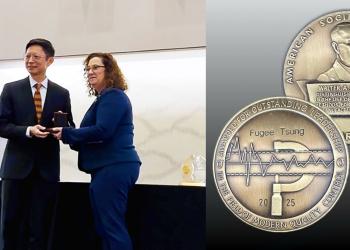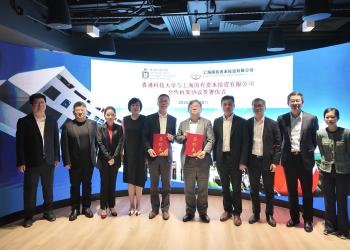HKUST Discovers New Aggregation-Induced Emission (AIE) Materials for Applications in Forensic Science and Bacterial Imaging
A Hong Kong University of Science and Technology research team led by Prof Benzhong Tang - Stephen Kam-chuen Cheong Professor of Science, Chair Professor of Chemistry and a member of the Chinese Academy of Sciences, has discovered new AIE materials which could be used on visualizing fingerprints and revealing bacteria with greater effectiveness. The new materials not only produce fingerprints of much better quality as compared to carbon powder, saving 90 per cent of the time in evidence collection, they also make a more accurate and stable agent in detecting bacterial activities.
Prof Tang has developed numerous AIE materials ever since his discovery of the AIE phenomenon in 2001, they were applied in a wide range of areas including high-performance OLEDs, cancer screening and environmental monitoring. His latest discoveries have expanded AIE’s applications into the arena of forensic science and bacterial detection.
Police and forensic scientists have long used carbon powder in obtaining fingerprints, they dust the powder over a latent print before lifting it onto an adhesive tape. However, such method can be time-consuming, and the quality of the print could also be compromised as part of the image may be lost during its transfer onto the tape.
With Prof Tang’s AIE material, however, no transfer is required. Police only need to take a picture of the fingerprint - which turns fluorescent when stained with the AIE material, and send the image back through a smart phone or a computer for comparison with the database. It is not just a lot more efficient but the quality of the print is also much better. The new material will also make collection of fingerprints easier on bended, round and uneven surfaces.
When used as a bacterial detecting agent, AIE material also offers more accurate and stable results than the widely-used propidium iodine (PI), which exposes the bacteria by staining its surface. Users must wash away excessive PI for better identification of the bacteria, inevitably some bacteria will be lost during the process. The fluorescent AIE material, however, exposes the bacteria by entering their cell walls, which turn them into a shiny organism. The merge between bacteria and the non-toxic AIE substance not only enhances the accuracy of the detection - as users are not required to wash away excessive agent, it also enhances the fluorescent period of the bacteria, thus allowing long-term tracking of them which is particularly useful for the sectors of environmental monitoring, medical hygiene, food processing and pharmaceutical quality control.
Prof Tang has researched on new AIE phenomena, processes and theories over the years, he explored AIE’s high-technological applications in chemosensors, bioprobes and optoelectronic devices, and received numerous awards for his discoveries of over 100 novel fluorescent materials - including one used for tracking cancer cells inside human body. AIE was incorporated into the National Basic Research Program - better known as 973 Program, in 2012, and awarded RMB 30 million in grants for its development.
For media enquiries, please contact:









